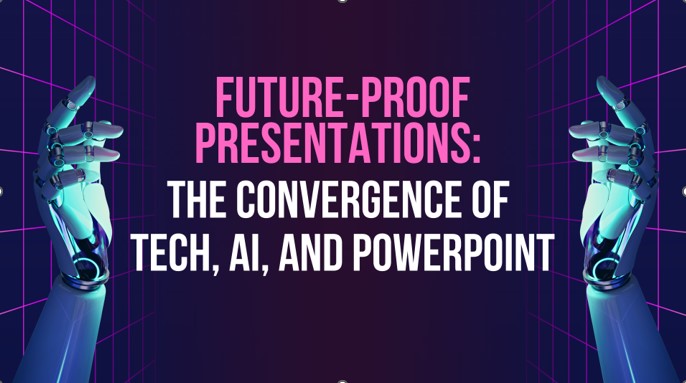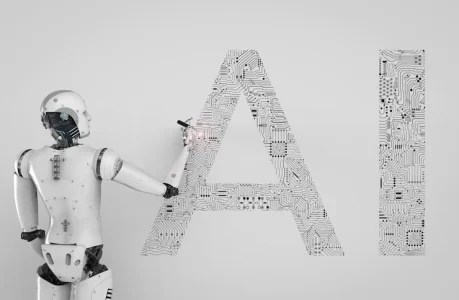Future-Proof Presentations: The Convergence Of Tech, AI, And Powerpoint

In today’s digital age, presentations are one of the effective forms of communication. Businesses, educators, and public speakers rely on presentations. They use this to convey complex ideas, ignite conversation, and drive decision-making. In fact, at some point, 35 million PowerPoint presentations are given daily. This indicates how ingrained this tool is in our professional lives.
These figures are impressive, but we must consider that attention spans are shrinking. The attention span now averages around eight seconds. This makes it even more crucial for presentations to be captivating.
Organizations now see the need for training like PowerPoint courses. They aim to stay relevant and updated in the evolving presentation landscape.
The art of delivering presentations still undergoes a significant transformation. From the early days of overhead projectors, presentations have always reflected technological advancements. We’re witnessing a drastic leap forward – the convergence of tech, AI, and PowerPoint. It now creates a blend of creativity and interactivity that was unthinkable before.
Let’s analyze this junction and the role of tech and AI in shaping future-proof presentations. This exploration will provide valuable insights to elevate your presentations, echoing cutting-edge knowledge. The future of presentations is not only about staying up-to-date. It is also about pushing the boundaries of what’s possible.
The Evolution Of Presentation Tools
In transforming ideas into visual storytelling, our presentation tools have evolved. It has taken us from the advent of PowerPoint to the current AI-driven presentations.
1. Traditional Powerpoint
Microsoft introduced PowerPoint in 1987 and dominated the presentation field. Its simple interface makes it popular in the corporate and educational sectors.
PowerPoint offers an assortment of tools for effective presentation techniques. From professional presentation templates to visual aids for presentations,
In a powerpoint course from Acuity training, you get various design ideas, tips, and tricks that allow users to elevate the look and feel of their slides.
But despite the advantages, traditional PowerPoint has its limitations. A static approach and lack of real-time interactivity sometimes make presentations less engaging.
Furthermore, while workable, data visualization often requires external tools for effective presentations. PowerPoint course from Acuity Training can ease these challenges. They equip users with business presentation skills and knowledge of design’s best practices.
2. Transition Toward Advanced Tech
As technology advanced, so did the need for more dynamic and interactive presentations. Other presentation software tools like Prezi, Google Slides, and Apple’s Keynote emerged.
They offer different approaches to slide design for presentations. This includes incorporating multimedia components to keep audiences captivated.
The integration of videos and real-time polls transformed the dynamics of presentations. These tools provided new creative presentation ideas. It breaks away from the traditional slide-by-slide format to a more interactive era.
The increasing need for engagement in presentations drove this transition. It also becomes a direct response to our fast-paced digital world.
3. Convergence with AI
The next big leap in presentation evolution is the integration of Artificial Intelligence. AI has found its way into presentation design. It provides tools that offer AI design help and automatic content generation. This makes it possible for presentations to adapt to the audience in real time.
AI-driven tools use smart technology to automate the design process. It offers professional templates that adjust as you add content. AI tools can also generate presentations based on text inputs, reducing design time.
There are many benefits of AI in presentations. AI can analyze the following:
- Large data sets
- Provide insights
- Convert insights into appealing presentations
- Adapt content based on audience response
But as with any technology, there are challenges too. Relying on AI may compromise the human touch in presentations. AI-driven tools become more sophisticated. Even professionals need to keep up with the changing landscape. This is why presentation training is critical.
Future-Proofing Presentations: The Essential Elements
As presentations evolve, certain core elements remain crucial to their success. Future-proofing presentations mean focusing on the following essential elements:
1. Adaptive And Responsive Design
An effective presentation is a flexible one. No matter who your audience is or what device they’re on, the experience should be seamless. This requires a layout that’s both adaptive and responsive.
Tools like PowerPoint offer the ability to adjust slide aspects like aspect ratio. It allows a better display across various screens. More advanced platforms incorporate adaptive design principles. It automatically adjusts content based on the device used for viewing.
Adaptive design is crucial in creating accessible presentations for individuals with different needs. Here are some of the ways it contributes:
- Flexible Layouts: Adaptive design accommodates different viewing formats. For example, someone with visual impairments prefers a layout that can adjust to larger text sizes. Do this without losing important design elements.
- Adjustable Media: Adaptive design enables control over images, videos, or audio clips—for instance, people with hearing impairments benefits from closed video captions.
- Color and Contrast Settings: You must provide options for adjusting color and contrast settings. This can help individuals with color blindness to perceive the content better.
Presentation skills training delve into these features. This enables you to create versatile and visually pleasing professional PowerPoint designs.
2. Artificial Intelligence In Design And Delivery
Artificial Intelligence is redefining how to design and deliver presentations. It assists in data analysis and converts information into digestible charts.
AI can generate creative PowerPoint designs. It can provide suggestions for visual aids and even help with PowerPoint animations. Here are some importance of Artificial Intelligence in design and delivery:
- Efficiency and Speed: AI can automate time-consuming aspects of design and delivery, like data visualization. It allows rapid and efficient creation and modification of presentations.
- Personalization: AI enables content customization to meet audiences’ preferences and needs. This improves their engagement and comprehension.
- Improved Accessibility: AI can provide real-time captions, transcriptions, and translations. This ensures that presentations are accessible to those who speak different languages.
- Data-Driven Insights: AI can analyze audience engagement data. It provides valuable insights into presentation effectiveness, guiding future improvements.
AI is now taking interactivity to a new level. It enables real-time audience responses, adapts presentation content, and answers audience questions.
3. Audience Engagement
The ultimate goal of any presentation is to engage the audience. In the age of reduced attention spans, audience-focused presentations are desirable and essential.
There’s been a shift towards interactive PowerPoint presentations. Now, audience members aren’t only passive listeners but active participants. They can answer live polls, ask questions, and share thoughts in real-time. This level of interaction keeps the audience involved and invested.
AI and tech play a significant role in facilitating audience interaction.
- AI-Powered Presentations: AI enhances the effectiveness of presentations. Through AI, presenters can leverage various tools for better delivery and interaction. This technology also creates automated summaries of the presentation. It highlights key points and is easy for the audience to remember.
- Data-Driven Presentations: Technology enables presenters to use big data in their presentations. Tech tools can track audience behavior, responses, and engagement level during the presentation. This analyzed data is to understand what works and what doesn’t. This allows continuous improvement in future presentations.
- Augmented Reality (AR) and Virtual Reality (VR): AR and VR take audience engagement to another level by offering immersive experiences. VR allows the audience to dive into the presentation’s subject matter. This creates a unique and memorable experience. AR can enhance presentations by overlaying extra information. This includes visual elements in the physical world. It provides a richer and more interactive presentation experience.
Making Your Presentations Future-Proof
Technology, AI, and PowerPoint fusion pave the future of impactful presentations. This convergence opens doors to greater integration of AI and technology. It creates new possibilities for presentation design and delivery.
Also, technologies like virtual reality engage your audience in ways never before possible. It is important to be up-to-date with these emerging trends.
The world of presentations continues to evolve. Having cutting-edge skills is essential in this digital age. With these advancements, you can create compelling presentations that align with modern audiences.
To further your technology mastery, consider presentation skills training. They are ideal for refining your skills and learning about the latest AI integration. It includes discovering how to leverage these technologies to create effective, engaging presentations.
Approach these new trends with curiosity and an openness to experimentation. Remember that each step forward is a valuable learning experience. Forward-thinking, adaptable, and innovative will lead the way. So, continue to push the boundaries of what’s possible with your presentations.
Read Also:

























Leave A Reply